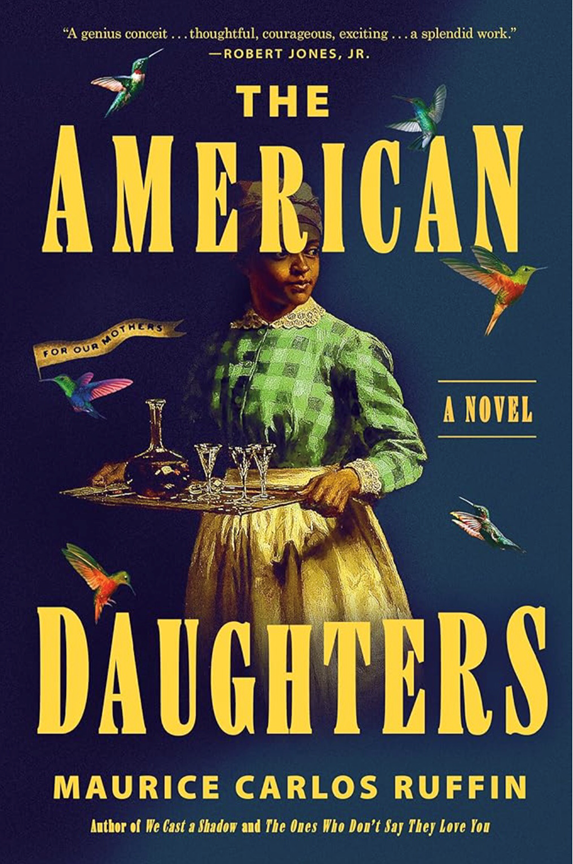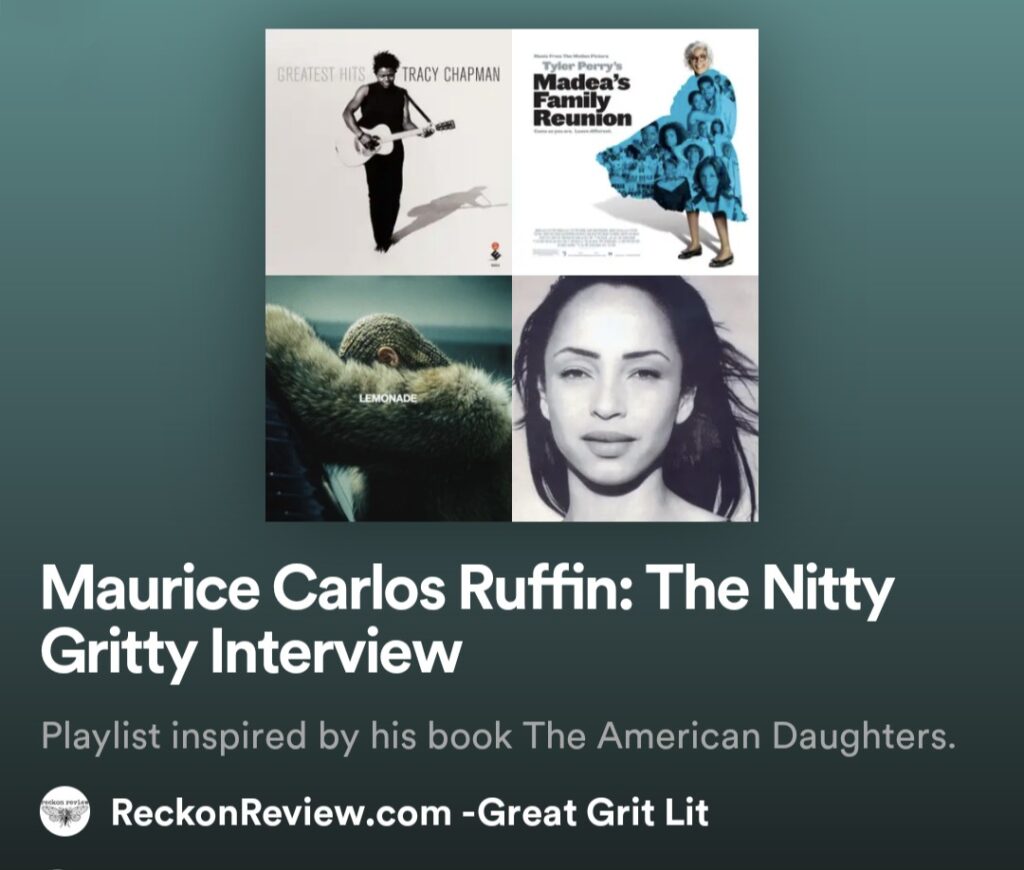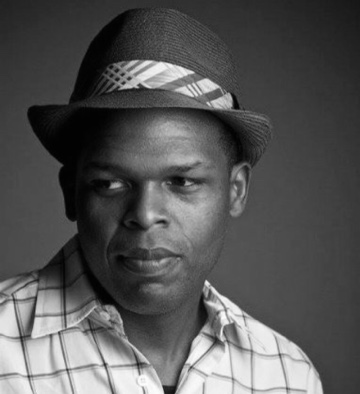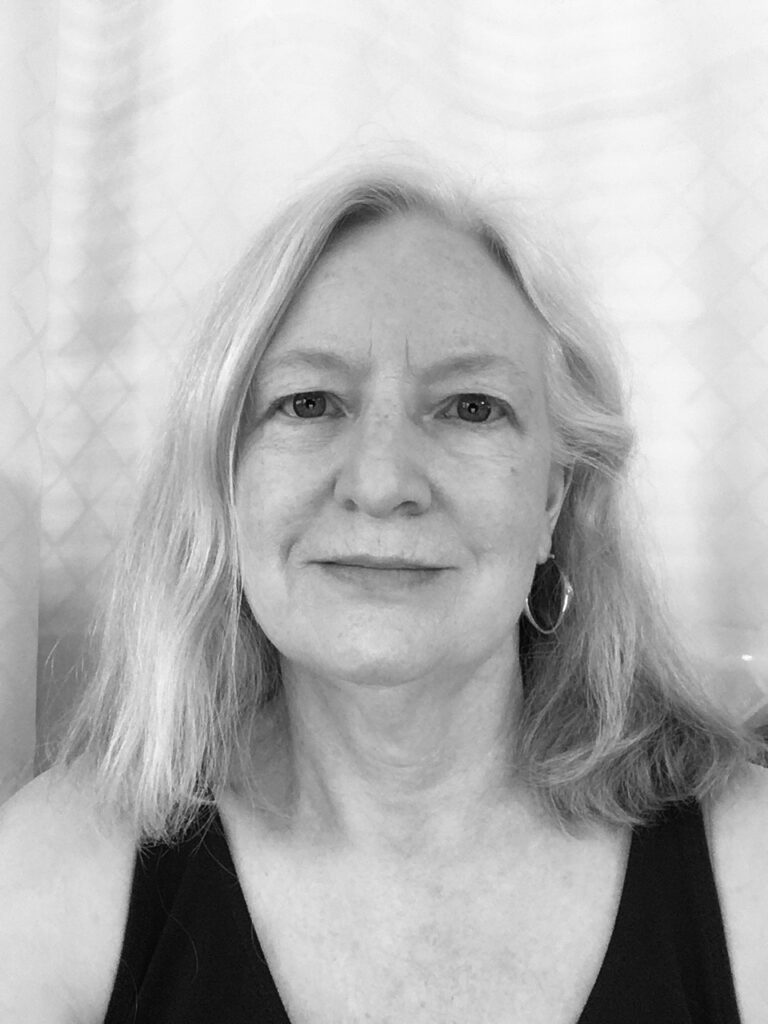By Charlotte Hamrick
Maurice Carlos Ruffin is a kind human being. Although he’s incredibly busy currently with a book tour, he is always available and responsive to questions from his fans (me!) and always has an open and beaming smile which is an invitation in itself to talk. I own all three of Maurice’s books, all of which are The New York Times Editors Choice books, so I can say with authority that Maurice writes with heart – a big exploring heart. He also pens a Substack with podcasts, Sitting in Silence, where he shares information about the craft of writing – real information that you, as a writer, can put into practice. I recommend it.
I recently put some questions to him about his National Bestseller, The American Daughters published by One World Random House, and his writing practice and journey.

What are some of the questions you asked yourself when you began writing this book?
How could I write about an experience that has been so linked to extreme trauma in the past without perpetuating that trauma?
How could I write a book that showed these characters from angles we haven’t seen before?
What is the proper span of time to write about?
What is the best cast of characters for this kind of story?
How much screentime to give the slaveowners?
Why do I want to tell this story and who is it for?
How can I surprise and delight my readers?
What perspectives or beliefs do you think you’ve challenged with this book?
That Black women and girls were passive victims of chattel slavery who experienced only trauma. I wanted to show something I’d never seen: these groups of women having conversations and relationships that we rarely see in other texts and films. And I wanted to show their deep love for one another.
Tell us a little about your writing routine as you were working on the manuscript.
I wrote the first draft from December 2020 to about mid-March 2021. Then I sat the pie on the counter to cool until summer and made revisions. Then let it sit until fall 2022. I turned it in, my editor loved it. So did my agent. As for my actual routine, during the first phase I only wrote about three times a week but sometimes up to 12 hours per day (with breaks for comfort and eating). I liked to cook meals and watch anime to rest my mind. On off days, I worked out and watched foreign cinema.
Did you use beta readers for this book?
Yes. I always have at least three beta readers for the first solid draft (which is actually draft four or 10 or etc.). Then I had two more readers come in late 2022 for punch-up comments.
How do you resolve advice or opinions that might not align with your voice or vision?
Good advice rings like a pure note from a tuning fork. You know the note is right the second you hear it. It makes sense to take good advice. Other advice isn’t good to the extent it doesn’t align with what I’m cooking. I’m not going to add chicken stock to my cake no matter how good the stock is.
Talk about the relationship between history and imagination in your writing.
All history is unknowable on some level because we can only depict slivers of it. Even depicting a dinner party you attended over the weekend or a commotion you witnessed in the supermarket requires a series of choices that leave out the unknowns. Writers like Toni Morrison, Edgar P. Jones, Charles Johnson, and others have taught me that I don’t need to know everything about the past to tell a good historical tale. I need a few pertinent facts as fertile soil for the seed of my book to sprout from. A sharp passage in a non-fiction book led to much of The American Daughters. And reading Mrs. Dalloway—an old fiction book—did wonders for helping me figure out the tone and voice I wanted to use.
What are some of the historical documents or oral stories used for this writing?
Indeed, the initial idea came from rooting around in an archive in the French Quarter 20 years ago! I researched chattel slavery advertisements, narratives of enslaved people, photobooks of places that existed at the time, communiques from presidents to military leaders, and plenty of nonfiction books. I also relied on the kinds of stories my women elders have told me my whole life that demonstrate their wiliness, strength, intellect, and care.
You wrote a story about the inner and physical strength of the daughters, of their challenges and how they were met with steel determination. Was it a challenge for you to write from a female perspective?
It would have been a long time ago. But I recognized my limitations as a nascent writer. Then I trained for a long time to become more honest and authentic in my depictions. I wrote many short stories featuring female characters from about 2008 through 2020. That was necessary work for me to render these women with the respect and realism they deserved.
I was intrigued by the glimpse you gave us of James and Sanite’s life in the bayou before abduction. Might there be a prequel telling their story?
I would love to do that. I don’t think I’m done with this universe of characters, so I may return to them at some point. I can’t say that for most of my stories. Their back story is based on historical facts about escaped enslaved people who found freedom outside of the city with Native American tribes. In New Orleans, Black performers called Mardi Gras Indians still pay homage to those tribes year-round.
If you were to write a spin-off about a side character, which would you pick and why?
Alabama has had many adventures that I know would thrill me and readers. I also think her solo story would be very, very saucy and fun. She’s probably the most confident character in the book. I’d follow her anywhere!
Who are your biggest writing influences?
Morrison, Baldwin, Nabokov, Woolf. If you know them by one name, they’ve probably influenced me. Of course, “amateurs are influenced by others, real writers steal.” I’ve stolen from them and many, many other writers including Chris Claremont, Colson Whitehead, Cathy Guisewite, and some whose given names don’t start with “C.”
What is the most valuable piece of advice you’ve been given about writing?
I’ve gotten a lot of top shelf advice, but I’ll go with: It doesn’t really matter what you write if no one is moved by it. He didn’t say this directly, but my professor Neal Walsh implied it once in a class during my MFA.

Editor’s note: I put together a Reckon Review Spotify playlist of strong African-American women inspired by The American Daughters: Maurice Carlos Ruffin
Enjoy!

Maurice Carlos Ruffin
Maurice Carlos Ruffin is the author of National Bestseller, The American Daughters, a New York Times Editor’s Choice published by One World Random House. He is the recipient of the 2023 Louisiana Writer Award and the Black Rock Senegal Residency. He also wrote The Ones Who Don’t Say They Love You, which was published by One World Random House in August 2021. It is the 2023 One Book One New Orleans selection. The book was a New York Times Editor’s Choice, a finalist for the Ernest J. Gaines Award for Literary Excellence and longlisted for the Story Prize. The book was also selected to represent Louisiana at the 2023 National Book Festival. His first book, We Cast a Shadow, was a finalist for the PEN/Faulkner Award, the Dayton Literary Peace Prize, and the PEN America Open Book Prize. It was longlisted for the 2021 DUBLIN Literary Award, the Center for Fiction Prize, and the Aspen Words Literary Prize. The novel was also a New York Times Editor’s Choice. His work appeared in the New York Times, the LA Times, Oxford American, Garden & Gun, Kenyon Review, and Four Hundred Souls: A Community History of African America. A New Orleans native, Ruffin is a professor of Creative Writing at Louisiana State University, and the 2020-2021 John and Renee Grisham Writer-in-Residence at the University of Mississippi. Ruffin was the 2022 Grand Marshal of the Mardi Gras Krewe of House Floats and recipient of the 2022 Louisiana Board of Regents ATLAS grant.

Charlotte Hamrick
Charlotte Hamrick’s creative writing and photography has been published in a number of literary journals and anthologies including Still: The Journal, The Citron Review, Atticus Review, Reckon Review, Trampset, and New World Writing, among many others. Her fiction was selected for the Best Small Fictions 2022 and 2023 anthologies and she’s had several literary nominations including the Pushcart Prize, Best of the Net, Best Small Fictions, and Best Microfiction. She was formerly Creative Nonfiction Editor for The Citron Review and Barren Magazine. She also writes intermittently on her Substack, The Hidden Hour. She lives in New Orleans with her husband and a menagerie of rescued pets where she sometimes does things other than read and write.
